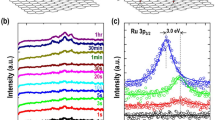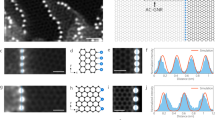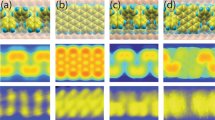Abstract
The fragmentation of fullerenes using ions, surface collisions or thermal effects is a complex process that typically leads to the formation of small carbon clusters of variable size. Here, we show that geometrically well-defined graphene quantum dots can be synthesized on a ruthenium surface using C60 molecules as a precursor. Scanning tunnelling microscopy imaging, supported by density functional theory calculations, suggests that the structures are formed through the ruthenium-catalysed cage-opening of C60. In this process, the strong C60–Ru interaction induces the formation of surface vacancies in the Ru single crystal and a subsequent embedding of C60 molecules in the surface. The fragmentation of the embedded molecules at elevated temperatures then produces carbon clusters that undergo diffusion and aggregation to form graphene quantum dots. The equilibrium shape of the graphene can be tailored by optimizing the annealing temperature and the density of the carbon clusters.
This is a preview of subscription content, access via your institution
Access options
Subscribe to this journal
Receive 12 print issues and online access
$259.00 per year
only $21.58 per issue
Buy this article
- Purchase on Springer Link
- Instant access to full article PDF
Prices may be subject to local taxes which are calculated during checkout





Similar content being viewed by others
References
Geim, A. K. & Novoselov, K. S. The rise of graphene. Nature Mater. 6, 183–191 (2007).
Novoselov, K. S. et al. Electric field effect in atomically thin carbon films. Science 306, 666–669 (2004).
Choucair, M., Thordarson, P. & Stride, J. A. Gram-scale production of graphene based on solvothermal synthesis and sonication. Nature Nanotech. 4, 30–33 (2009).
Li, X. L., Wang, X. R., Zhang, L., Lee, S. W. & Dai, H. J. Chemically derived, ultrasmooth graphene nanoribbon semiconductors. Science 319, 1229–1232 (2008).
Li, D., Muller, M. B., Gilje, S., Kaner, R. B. & Wallace, G. G. Processable aqueous dispersions of graphene nanosheets. Nature Nanotech. 3, 101–105 (2008).
Ponomarenko, L. A. et al. Chaotic Dirac billiard in graphene quantum dots. Science 320, 356–358 (2008).
Kosynkin, D. V. et al. Longitudinal unzipping of carbon nanotubes to form graphene nanoribbons. Nature 458, 872–875 (2009).
Schwierz, F. Graphene transistors. Nature Nanotech. 5, 487–496 (2010).
Cai, J. M. et al. Atomically precise bottom-up fabrication of graphene nanoribbons. Nature 466, 470–473 (2010).
Pan, D. Y., Zhang, J. C., Li, Z. & Wu, M. H. Hydrothermal route for cutting graphene sheets into blue-luminescent graphene quantum dots. Adv. Mater. 22, 734–738 (2010).
Li, L. S. & Yan, X. Colloidal graphene quantum dots. J. Phys. Chem. Lett. 1, 2572–2576 (2010).
Otero, G. et al. Fullerenes from aromatic precursors by surface-catalysed cyclodehydrogenation. Nature 454, 865–819 (2008).
Chuvilin, A., Kaiser, U., Bichoutskaia, E., Besley, N. A. & Khlobystov, A. N. Direct transformation of graphene to fullerene. Nature Chem. 2, 450–453 (2010).
Krishna, V., Stevens, N., Koopman, B. & Moudgil, B. Optical heating and rapid transformation of functionalized fullerenes. Nature Nanotech. 5, 330–334 (2010).
Cepek, C., Goldoni, A. & Modesti, S. Chemisorption and fragmentation of C60 on Pt(111) and Ni(110). Phys. Rev. B 53, 7466–7472 (1996).
Swami, N., He, H. & Koel, B. E. Polymerization and decomposition of C60 on Pt(111) surfaces. Phys. Rev. B 59, 8283–8291 (1999).
Marchini, S., Gunther, S. & Wintterlin, J. Scanning tunneling microscopy of graphene on Ru(0001). Phys. Rev. B 76, 075429 (2007).
Wang, B., Bocquet, M. L., Marchini, S., Gunther, S. & Wintterlin, J. Chemical origin of a graphene moire overlayer on Ru(0001). Phys. Chem. Chem. Phys. 10, 3530–3534 (2008).
Sutter, E., Acharya, D. P., Sadowski, J. T. & Sutter, P. Scanning tunneling microscopy on epitaxial bilayer graphene on ruthenium (0001). Appl. Phys. Lett. 94, 133101 (2009).
Wang, W. L., Yazyev, O. V., Meng, S. & Kaxiras, E. Topological frustration in graphene nanoflakes: magnetic order and spin logic devices. Phys. Rev. Lett. 102, 157201 (2009).
Ritter, K. A. & Lyding, J. W. The influence of edge structure on the electronic properties of graphene quantum dots and nanoribbons. Nature Mater. 8, 235–242 (2009).
Barone, V., Hod, O. & Scuseria, G. E. Electronic structure and stability of semiconducting graphene nanoribbons. Nano Lett. 6, 2748–2754 (2006).
Berger, C. et al. Electronic confinement and coherence in patterned epitaxial graphene. Science 312, 1191–1196 (2006).
Xu, K., Cao, P. G. & Heath, J. R. Scanning tunneling microscopy characterization of the electrical properties of wrinkles in exfoliated graphene monolayers. Nano Lett. 9, 4446–4451 (2009).
Zhang, Y. B. et al. Giant phonon-induced conductance in scanning tunnelling spectroscopy of gate-tunable graphene. Nature Phys. 4, 627–630 (2008).
Larsson, J. A. et al. Orientation of individual C60 molecules adsorbed on Cu(111): Low-temperature scanning tunneling microscopy and density functional calculations. Phys. Rev. B 77, 115434 (2008).
Casarin, M. et al. Strong bonding of single C60 molecules to (1×2)-Pt(110): an STM/DFT investigation. J. Phys. Chem. C 111, 9365–9373 (2007).
Lacovig, P. et al. Growth of dome-shaped carbon nanoislands on Ir(111): the intermediate between carbidic clusters and quasi-free-standing graphene. Phys. Rev. Lett. 103, 166101 (2009).
Felici, R. et al. X-ray-diffraction characterization of Pt(111) surface nanopatterning induced by C60 adsorption. Nature Mater. 4, 688–692 (2005).
Li, H. I. et al. Surface geometry of C60 on Ag(111). Phys. Rev. Lett. 103, 056101 (2009).
Schulze, G. et al. Resonant electron heating and molecular phonon cooling in single C60 junctions. Phys. Rev. Lett. 100, 136801 (2008).
Coraux, J. et al. Growth of graphene on Ir(111). New J. Phys. 11, 023006 (2009).
Chen, H., Zhu, W. G. & Zhang, Z. Y. Contrasting behavior of carbon nucleation in the initial stages of graphene epitaxial growth on stepped metal surfaces. Phys. Rev. Lett. 104, 186101 (2010).
Sutter, P. W., Flege, J. I. & Sutter, E. A. Epitaxial graphene on ruthenium. Nature Mater. 7, 406–411 (2008).
Mo, Y. W., Swartzentruber, B. S., Kariotis, R., Webb, M. B. & Lagally, M. G. Growth and equilibrium structures in the epitaxy of Si on Si(001). Phys. Rev. Lett. 63, 2393–2396 (1989).
Soler, J. M. et al. The SIESTA method for ab initio order-N materials simulation. J. Phys. Condens. Matter 14, 2745–2779 (2002).
Ceperley, D. M. & Alder, B. J. Ground state of the electron gas by a stochastic method. Phys. Rev. Lett. 45, 566–569 (1980).
Troullier, N. & Martins, J. L. Efficient pseudopotentials for plane-wave calculations. Phys. Rev. B 43, 1993–2006 (1991).
Tersoff, J. & Hamann, D. R. Theory of the scanning tunneling microscope. Phys. Rev. B 31, 805–813 (1985).
Acknowledgements
K.P.L acknowledges funding support from an NRF-CRP grant ‘Graphene related materials and devices’ (R-143-000-360-281) as well as MOE Tier 2 grant ‘Structure and dynamics of molecular self-assembled films’ (R-143-000-344-112).
Author information
Authors and Affiliations
Contributions
J.L. and K.P.L. conceived and designed the experiments. J.L. performed the STM and STS measurement. P.S.E.Y. carried out theoretical calculations. C.K.G and W.P contributed analysis tools. K.P.L supervised the project. All authors discussed the results and analysed the data.
Corresponding author
Ethics declarations
Competing interests
The authors declare no competing financial interests.
Supplementary information
Supplementary information
Supplementary information (PDF 1205 kb)
Supplementary information
Supplementary movie 1 (WMV 740 kb)
Supplementary information
Supplementary movie 2 (WMV 795 kb)
Rights and permissions
About this article
Cite this article
Lu, J., Yeo, P., Gan, C. et al. Transforming C60 molecules into graphene quantum dots. Nature Nanotech 6, 247–252 (2011). https://doi.org/10.1038/nnano.2011.30
Received:
Accepted:
Published:
Issue Date:
DOI: https://doi.org/10.1038/nnano.2011.30
This article is cited by
-
Graphene quantum dots as game-changers in solar cell technology: a review of synthetic processes and performance enhancement
Carbon Letters (2024)
-
A review on synthesis, challenges as well as future prospects of graphene quantum dot (GQD)
Pramana (2024)
-
2D carbon network arranged into high-order 3D nanotube arrays on a flexible microelectrode: integration into electrochemical microbiosensor devices for cancer detection
NPG Asia Materials (2023)
-
A rapid and sensitive method to detection of Cr3+by using the Fe3O4@Pectin-polymethacrylimide@graphene quantum dot as a sensitive material
Chemical Papers (2023)
-
Quinoline-infused graphene carbon cages: an ecofriendly approach towards environmental remediation
Research on Chemical Intermediates (2023)



